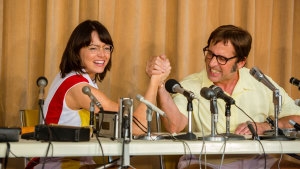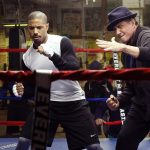ASMR Comes To Hollywood In “Battle Of The Sexes”
The most riveting scene in Battle of the Sexes–a thrilling and accurate restaging of the famous 1973 man-versus-woman tennis showdown between Billie Jean King and Bobby Riggs–occurs not on a tennis court but in a beauty salon. Early in the film, a then-married King (played by Emma Stone) encounters hairdresser Marilyn Barnett (Andrea Riseborough) for the first time.
They’re surrounded by other women who have left the United States Lawn Tennis Association tour to start their own tour, because they aren’t getting paid nearly as much as male players, and they swing into the salon to get their hair done. But there is a quietly seductive interaction going on between the two women, who clearly feel an instantaneous attraction, as Barnett trims King’s locks.
The directors, Valerie Faris and Jonathan Dayton, used a special close-up lens to capture the looks exchanged between the women and their telling gestures, but it isn’t just the visual close-ups that establish the intimacy. It’s the sound mix, too–the scissors snipping, the whoosh of the blow dryers, and the other sounds of the salon melt away at one point, turning the whispers shared between King and Barnett into audio close-ups.
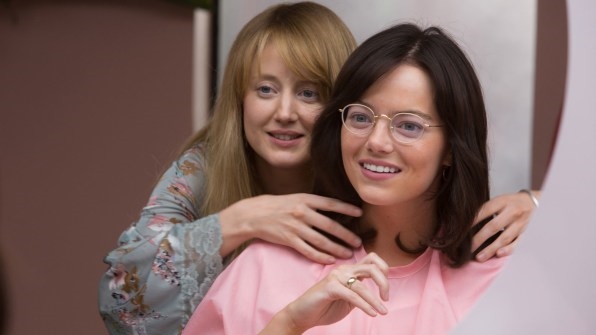
The directors were intentionally attempting to generate an autonomous sensory meridian response, known as AMSR for short. “It’s this effect created when somebody like a dental hygienist, or someone cutting your hair, or doing your makeup, talks in a certain way,” Faris explains. “There’s a certain response that it elicits, not for everyone, but for some people–it’s relaxing.”
ASMR first became popular on YouTube, where you can find dozens of videos made by directors who specialize in the form. And fans have picked out scenes in various movies that may trigger a similarly spine-tingling level of intimacy. But this is perhaps the first time film directors have admitted to creating a scene in order to get an ASMR-like reaction.
“People work to make videos that elicit this response,” Dayton says, “and we were wondering, ‘Could we get that response in a theater full of people?’” (It worked for me.)
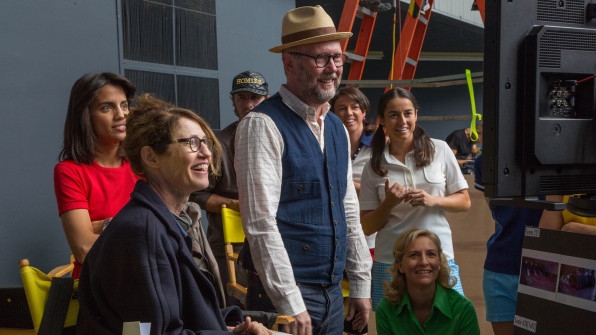
There are, of course, some fantastic tennis scenes as well. “There aren’t many great tennis movies, so we wanted to get the tennis right, without question,” Dayton says.
But the directors stress that they didn’t want to shoot a master class on how to nail a backhand. This film is the personal story of an athlete and feminist who publicly fought for women’s equality while privately coming to terms with her own sexuality. “That was a story that hasn’t been told,” Dayton says.
That meant making scenes that were “as visceral, as felt as possible,” Faris says. “I think everyone knows it feels so good to have someone run their fingers through your hair and be touched in that way.”
Soon after that chance meeting, King gets involved in a secret love affair with Barnett while preparing for the legendary match against Riggs (played by Steve Carell). She has to win, not only for the sake of herself, women’s tennis, and the women’s lib movement at large but because her opponent is an anti-feminist who declares that he prefers women serving in the kitchen and the bedroom rather than on the tennis court.
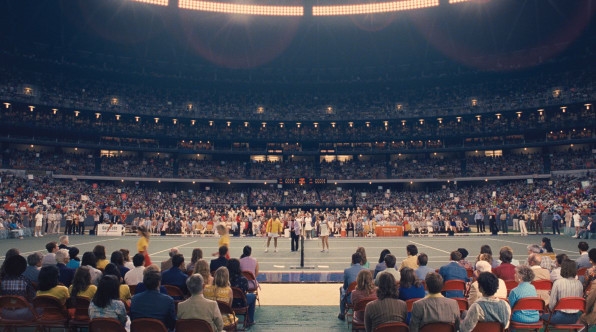
King doesn’t fall for the bait when Riggs taunts her with his nonsense–she calmly stays in control and above the fray. “She never engaged in name calling,” Dayton says, stressing that one of the lessons to be taken from the film is, “You’ve got to respect your opponent. She won this match because she respected Bobby Riggs as a player.”
It would be easy to portray Riggs as nothing more than a sexist clown, but the Battle of the Sexes screenplay written by Simon Beaufoy (Slumdog Millionaire) presents the onetime tennis champ as a middle-aged man who loves his young son and wants nothing more than to save his floundering marriage, which is under threat because of his gambling addiction, but will also do anything to be back in the limelight.
“We wanted to humanize Bobby,” Dayton says. “It’s not to say that he wasn’t a chauvinist, or that he is forgiven, but just to keep the complexity of him as a person, and to also ultimately show that so much of his public persona was an act designed to aggravate and to attract attention to himself.”
The filmmakers also wanted filmgoers to see how systemic sexism was in the 1970s, and still is to this day. King wasn’t just battling Riggs, she was taking on the United States Lawn Tennis Association and the media. The film’s re-creation of the Battle of the Sexes match at the Houston Astrodome includes real audio recordings of sportscaster Howard Cosell, who said during the match, “If she ever let her hair grow down to her shoulders and took her glasses off, you’d have someone vying for a Hollywood screen test.” (Amazingly, some 600 people called the Chicago TV station broadcasting the match to complain–not about Cosell, but his cohost, tennis pro Rosie Casals.)
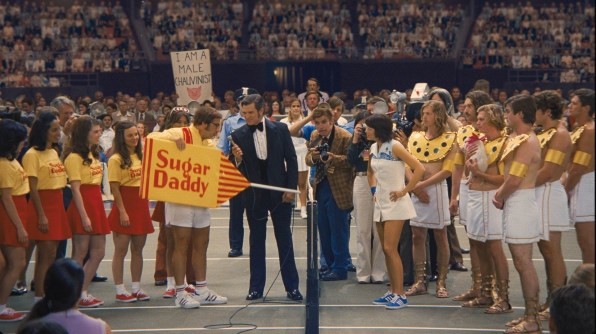
As in the film, Sugar Daddy, makers of those caramel candy bars on a stick, proudly sponsored Riggs. He wore a jacket with the Sugar Daddy logo on it during the Battle of the Sexes match and presented King with the gift of a giant-sized Sugar Daddy prior to their showdown. The result? Even though King triumphed in the $100,000 winner-take-all match, earning a then record-breaking sum for a female tennis star, Riggs still walked away with $50,000 from the candy maker.
“That was just another sign of systemic sexism,” Dayton says. “Can you imagine a company sponsoring someone who was saying the things Riggs said today?”
The backlash would be swift. Though let’s not kid ourselves: The Trump Organization would probably be all too willing to support that cause.
Fast Company , Read Full Story
(79)

